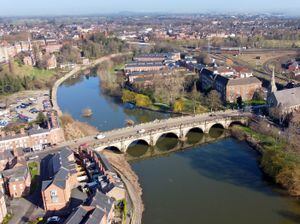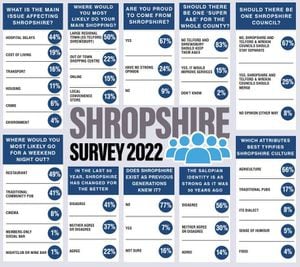Plenty of pride among Shropshire residents - but hospital delays a major cause for concern
Shropshire isn't what it used to be, but people still feel great pride in their county.

That is the verdict of Shropshire readers who took part in our 2022 Shropshire Survey, 10 years after it was carried out for the first time.
We invited our readers to explain what it means to live in Shropshire in 2022, by answering a range of questions about their hopes and fears, and what the county means to them.
The good news is that out of a whopping 1,712 people who took part, an overwhelming majority felt a sense of pride in where they were from.
A total of 64 per cent said they felt proud to be from Shropshire, compared to just nine per cent who did not. More than a quarter, though, expressed indifference to the question.
But while Salopians still feel proud of their county, it seems they are less happy with the direction in which it is heading.
Just over three quarters said Shropshire no longer existed as previous generations knew it, compared to seven per cent who believed it still did.

Perhaps more tellingly, 56 per cent felt that the Shropshire identity had diminished over the past 30 years, compared to just 14 per cent who felt it had not. The remainder said they had no strong opinion either way.
While it seems most agree that the county has changed considerably, most appear to feel pessimistic about the change. When asked if Shropshire had changed for the better over the past 50 years, only 22 per cent said they thought it had, while 41 per cent said it hadn't, with 37 per cent having no strong view either way.
When asked what best typifies Shropshire culture, two thirds cited the region's agricultural heritage, followed by 17 per cent who said traditional community pubs.
While the area now known as Telford is famous for its 'eh up, jockey' dialect, this does not appear to be particularly important to the identity of the county as a whole, with just eight per cent saying it was important. Five per cent said Shropshire's sense of humour was central to the county's identity, and four per cent mentioned Salopian food.
While people clearly take great pride in the area, there is very little support for a single local authority to cover the whole of the county.
A quarter of those surveyed thought Telford & Wrekin and Shropshire councils should merge to form a single authority for the county, compared to two-thirds who were opposed to the idea. Eight per cent said they had no opinion either way.
Hospital delays are by some margin the single biggest concern of people in the county, with 44 per cent citing it as the number one issue. But proposals to streamline hospital services with a "super A & E" serving the whole of the county were met with little support, with just 15 per cent being in favour of the idea, and 83 per cent against.

Hospitals aside, the cost of living was the next biggest problem in the county, with almost a fifth saying it was their top concern.
Just under one in six said improving transport should be the top priority, while one in nine said housing was the biggest issue. Only four per cent felt the environment was the number one issue.
The survey suggests the days of the traditional members only social clubs could be coming to an end, with nobody who took part saying it is where they would go for a night out at a weekend.
Almost half said a restaurant was their most likely destination, followed by a traditional community pub which took 41 per cent of the vote. Eight per cent said they would go to the cinema, and just two per cent said a nightclub or wine bar – perhaps reflecting both the county's ageing population, but also the societal changes of the past decade or so, which has seen a rapid decline in the nightclub trade.
On the other hand, it appears that the demise of the high street at the hands of online shopping may have been somewhat exaggerated.
Just 15 per cent said they did their main household shopping on the worldwide web, compared to half who regularly visited their local town centre. Just over a fifth said they would go to an out-of-town shopping centre, while 13 per cent opted for their local convenience store. It would appear that, in Shropshire at least, people still prefer to buy things in person rather than wait for the delivery van to arrive.





